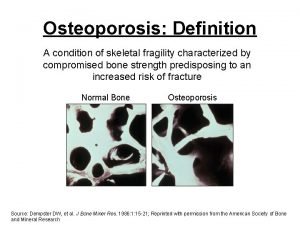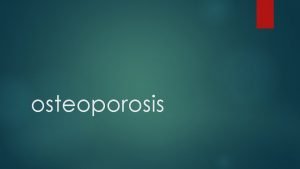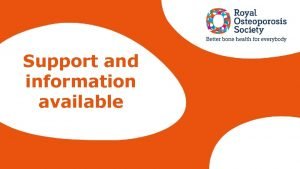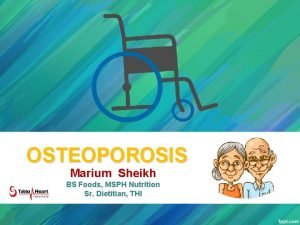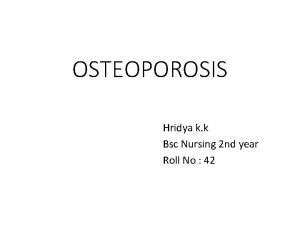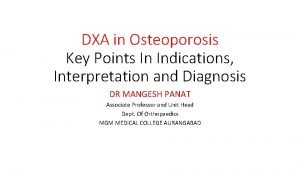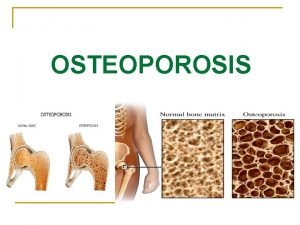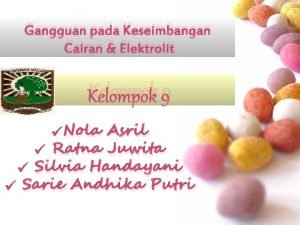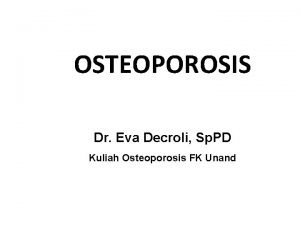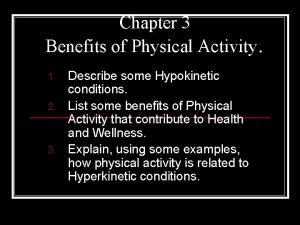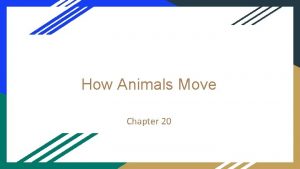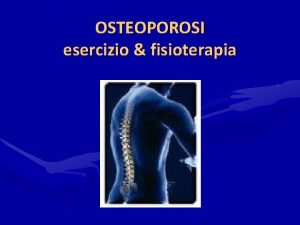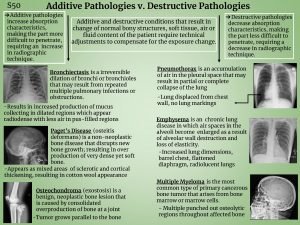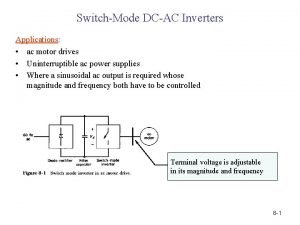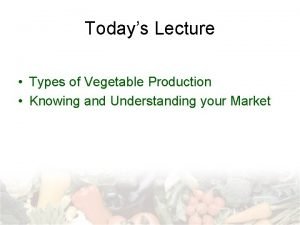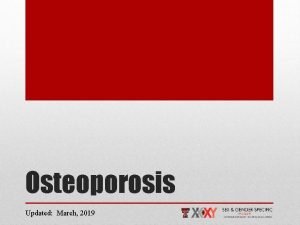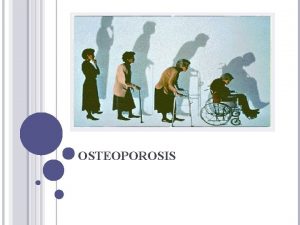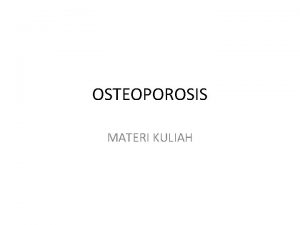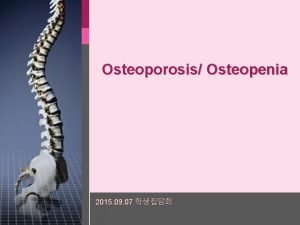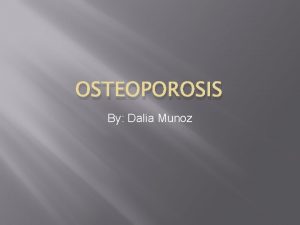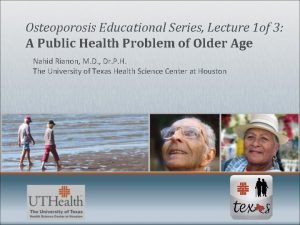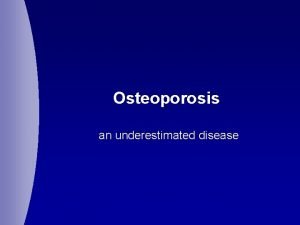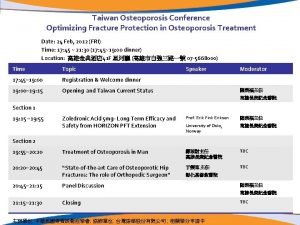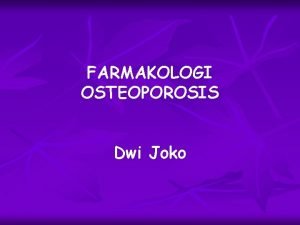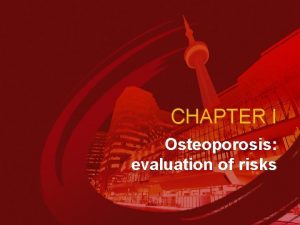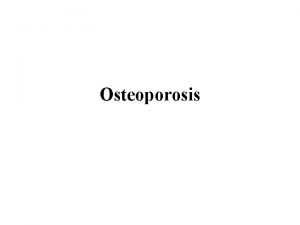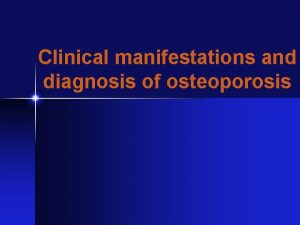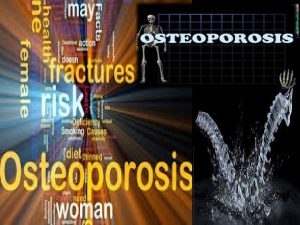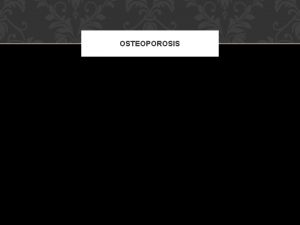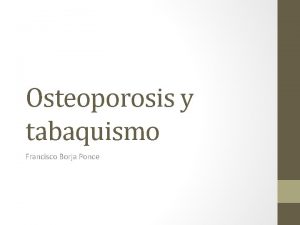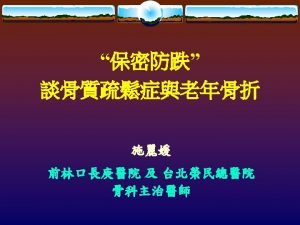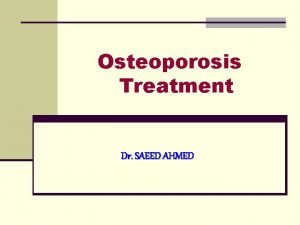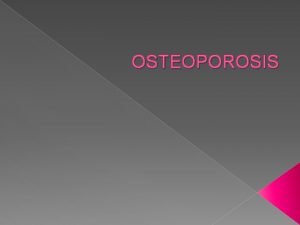Osteoporosis Educational Series Lecture 2 of 3 Understanding



























- Slides: 27

Osteoporosis Educational Series, Lecture 2 of 3: Understanding Bone to Understand Osteoporosis: Pathogenesis and Risk Factors Nahid Rianon, M. D. , Dr. P. H. The University of Texas Health Science Center at Houston

Goal and Objectives GOAL: The goal of this presentation is to describe detail mechanism of bone loss and risk of fractures LEARNING OBJECTIVES: At the end of this presentation, attendees will be able to w Explain normal and abnormal state of bone metabolism w Define bone remodeling w Identify risk factors for bone loss w Calculate risk of facture

Pre Quiz Question 1 of 5 What percent of adult human bone is made of minerals? a) 20% b) 65% c) 75% d) 90%

Pre Quiz Question 2 of 5 Which of the following factors stimulate osteoblasts? (Choose one) a) b) c) d) Glucocorticoids and Estrogen Thyroxine and Androgen Estrogen and Growth Hormone Vitamin D and Thyroxine

Pre Quiz Question 3 of 5 Which one of the following statements best fits the pathological state of osteoporosis due to age related bone loss? a) b) c) d) Bone formation and resorption are in balance Both formation and resorption slows down at the same rate Both formation and resorption increases at the same rate Bone resorption is greater than bone formation

Pre Quiz Question 4 of 5 Which of the following diseases is not considered a risk for developing secondary osteoporosis (when remains untreated) for FRAX calculation tool? a) b) c) d) Diabetes Mellitus type II Hypothyroidism Diabetes Mellitus type I Osteogenesis Imperfecta in adults

Pre Quiz Question 5 of 5 In humans, trabecular bone volume is larger than cortical bone volume? a) True b) False

Why Do We Need Strong Bones: Function w Mechanical w w Weight bearing Protection for soft organs Attachment for muscles Mineral reservoir w w Calcium Phosphorus

Bone Structure Overall w Organic Matrix w w w Mineral Component w w 10% of adult bone Primarily protein collagen -provides flexibility 65% of adult bone Hydroxyapatite - insoluble salts of calcium (99%) & phosphorus (85%) Very little Mg, Na & HCO 3 Water w 25% of adult bone

Bone Structure Cellular w Osteoblasts w w Osteoclasts w w Critical to bone formation Reabsorb bone Osteocytes Osteoblasts Osteoclasts Exact role is still under investigation w Osteocytes

Bone Structure Types of bone Trabecular w w w 20% of skeletal mass Greater surface area than cortical Provides supporting strength to the ends of weight-bearing bones Cortical w w 80% of skeletal mass Solid outside shaft of long bones Forces on bone Compressive stress w From body weight pushing the bone down Tensile stresses w From muscles, pulling the bone apart

Trabecular and Cortical Bones Trabecular bone Cortical bone Mineral loss Tensile Comprehensive Healthy femur Femur with loss of mineral and microstructure

Physiology- Normal State Bone Marrow Progenitors Osteoblast Precursor Glucocorticoids Estrogen Androgens GH/IGF-1 Osteoblast Osteoclast Precursor _ _ + + *Find out if this is 1, 25 (OH)2 D Estrogen Calcitonin Thyroxine Vitamin A 1, 25 OHD PTH New Bone Formation Osteoclast Bone Resorption Osteocyte

Pathogenesis Of Osteoporosis - Bone Remodeling Osteoclast Precursor Mononuclear Osteoclast Cells Osteoblast Precursors Osteoblast LEGEND: LC = Lining Cells CL = Cement Line OS = Osteoid BRU = Bone Remodeling Unit Normal Bone Remodeling Sequence Resorption = Formation No change in bone mass

Basic Pathology High bone turnover state Unbalanced remodeling Osteoporosis Normal Bone Structure Osteoporotic Bone Structure

Unbalanced Remodeling & Osteoporosis Resorption > Formation Influencers: • Inadequate calcium or vitamin D • Menopause • Aging • Medications or diseases Net bone loss

Osteoporosis Risk Factors w w w w Increasing age Female gender Early menopause Low body weight Previous fracture Family history Low calcium intake w w w w Low vitamin D Alcohol Smoking Physical inactivity High caffeine intake Drug use- steroid White or Asian race

FRAX Calculator

FRAX Risk Factors w w w Age (40 -90), gender, height & weight Previous fracture Hip fracture in parents Current smoking Alcohol Glucocorticoids (oral) ≥ 3 months @ dose 5 mg daily or more w or equivalent doses of other glucocorticoids w w Rheumatoid arthritis Secondary osteoporosis w w w DM-I, OI in adults, Untreated hyper or hypothyroidism, Premature menopause (< 45 yrs), Chronic malnutrition or malabsorption & Chronic liver disease Bone mineral density (BMD)

Post Quiz Question 1 of 5 What percent of adult human bone is made of minerals? a) 20% b) 65% c) 75% d) 90%

Post Quiz Question 2 of 5 Which of the following factors stimulate osteoblasts? (Choose one) a) b) c) d) Glucocorticoids and Estrogen Thyroxine and Androgen Estrogen and Growth Hormone Vitamin D and Thyroxine

Post Quiz Question 3 of 5 Which one of the following statements best fits the pathological state of osteoporosis due to age related bone loss? a) b) c) d) Bone formation and resorption are in balance Both formation and resorption slows down at the same rate Both formation and resorption increases at the same rate Bone resorption is greater than bone formation

Post Quiz Question 4 of 5 Which of the following diseases is not considered a risk for developing secondary osteoporosis (when remains untreated) for FRAX calculation tool? a) b) c) d) Diabetes Mellitus type II Hypothyroidism Diabetes Mellitus type I Osteogenesis Imperfecta in adults

Post Quiz Question 5 of 5 In humans, trabecular bone volume is larger than cortical bone volume? a) True b) False

Thank You Questions?

Reference • American Society for Bone and Mineral Research http: www. asbmr. org • WHO Fracture Risk Assessment Tool (FRAX) http: //www. sheffield. ac. uk/FRAX/tool. jsp

Brought to you by TEXAS. The Training Excellence in Aging Studies (TEXAS) program promotes geriatric training from medical school through the practicing physician level. This project is funded by the Donald W. Reynolds Foundation to the division of Geriatrics and Palliative Medicine within the department of Internal Medicine at The University of Texas Health Science Center at Houston (UTHealth). TEXAS would also like to recognize the following for contributions: Houston Geriatric Education Center Harris County Hospital District Memorial Hermann Foundation Huffington Lecture Series The TEXAS Advisory Board Othello "Bud" and Newlyn Hare UTHealth Medical School Office of the Dean UTHealth School of Nursing UTHealth Consortium on Aging UTHealth Multimedia Scriptorium (www. uth. tmc. edu/scriptorium) Ben Earwicker for the use if his photos (www. garrisonphoto. org/sxc) Photographs use for the cover are allowed by the morgue. File free photo agreement and the Royalty Free usage agreement at Stock. xchng. They appear on the cover in this order: • • • Wallyir at morguefile. com/archive/display/221205 Mokra at www. sxc. hu/photo/572286 Clarita at morguefile. com/archive/display/33743 Copyrighted images cannot be used in whole or part without the explicit permission of the owner.
 01:640:244 lecture notes - lecture 15: plat, idah, farad
01:640:244 lecture notes - lecture 15: plat, idah, farad Defination of osteoporosis
Defination of osteoporosis Osteoporosis defination
Osteoporosis defination Royal osteoporosis society leaflets
Royal osteoporosis society leaflets Pes statement for osteoporosis
Pes statement for osteoporosis God bone
God bone Subjective data for osteoporosis
Subjective data for osteoporosis Osteoporosis
Osteoporosis Osteoporosis t score
Osteoporosis t score Osteoporosis definition
Osteoporosis definition Woc osteoporosis
Woc osteoporosis Dr eva decroli
Dr eva decroli Is osteoporosis hypokinetic or hyperkinetic
Is osteoporosis hypokinetic or hyperkinetic Whole muscle
Whole muscle International osteoporosis foundation
International osteoporosis foundation Additive pathology in radiography examples
Additive pathology in radiography examples Geology lecture series
Geology lecture series Dcac lecture series
Dcac lecture series General feedback
General feedback Taylor series of composite functions
Taylor series of composite functions Series aiding and series opposing
Series aiding and series opposing Maclaurin series vs taylor series
Maclaurin series vs taylor series Arithmetic sequence formula
Arithmetic sequence formula Maclaurin series vs taylor series
Maclaurin series vs taylor series Ibm p series server
Ibm p series server Balmer series lyman series
Balmer series lyman series Othello lecture
Othello lecture Lecture vegetable
Lecture vegetable

